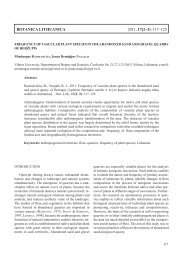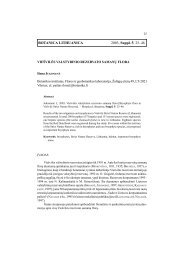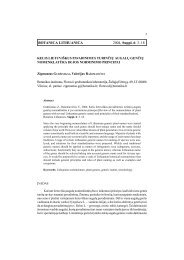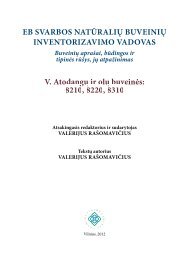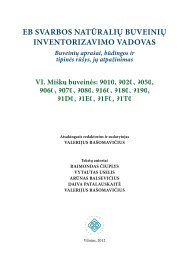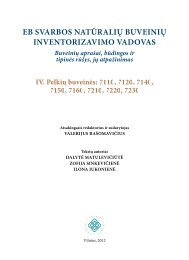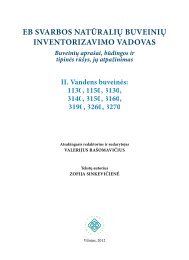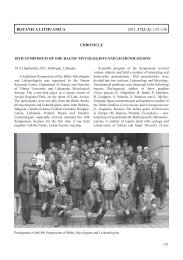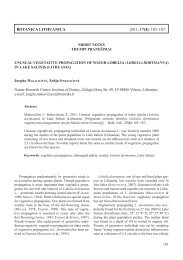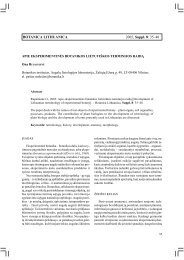FUNGI AND LICHENS IN THE BALTICS AND BEYOND XVIII ...
FUNGI AND LICHENS IN THE BALTICS AND BEYOND XVIII ...
FUNGI AND LICHENS IN THE BALTICS AND BEYOND XVIII ...
You also want an ePaper? Increase the reach of your titles
YUMPU automatically turns print PDFs into web optimized ePapers that Google loves.
MYCOLOGY<br />
OCCURENCE OF THREE RARE MYXOMYCETE SPECIES <strong>IN</strong> GREAT<br />
CORMORANT COLONY <strong>IN</strong> LITHUANIA<br />
G. ADAMONYTĖ 1 , R. TARAŠKEVIČIUS 2 , D. MATULEVIČIŪTĖ 1<br />
1 Institute of Botany, Nature Research Centre, Žaliųjų Ežerų Str. 49, LT-08406 Vilnius,<br />
Lithuania<br />
2 Institute of Geology and Geography, Nature Research Centre, Ševčenkos Str. 13,<br />
LT-03223 Vilnius, Lithuania<br />
E-mails: grazina.adamonyte@botanika.lt, taraskevicius@geo.lt,<br />
dalyte.matuleviciute@botanika.lt<br />
Three worldwide rare species – Arcyria leiocarpa, Badhamia apiculospora and<br />
Comatricha mirabilis – were recorded on various substrata in a colony of continental<br />
subspecies of a great cormorant (Phalacrocorax carbo sinensis) in the western Lithuania, the<br />
Curronian Spit. Seven collections of Comatricha mirabilis from litter, 22 collections of<br />
Arcyria leiocarpa from Sambucus spp. and Pinus sylvestris bark as well as litter, and 113<br />
collections of Badhamia apiculospora from Quercus robur, Sambucus spp., Pinus sylvestris<br />
bark and litter were obtained from moist chamber cultures. These are the first records of all<br />
three species for Lithuania. The greatest abundance of these myxomycetes was observed<br />
within the most active part of the colony with sporadic records in the oldest colony part and a<br />
territory adjacent to the colony (control plots). All species demonstrated their preference to<br />
substrates with high pH.<br />
Acknowledgements. This research was funded by a grant No LEK-23/2010 from the<br />
Research Council of Lithuania.<br />
Erysiphales – NEW TENDENCIES OF SYSTEMATICS<br />
B. BANK<strong>IN</strong>A, G. BIMSTE<strong>IN</strong>E<br />
Institute of Soil and Plant Sciences, Latvia University of Agriculture<br />
Liela Street 2, LV 3001 Jelgava, Latvia<br />
E-mail: Biruta.Bankina@llu.lv<br />
Mildew is a common disease of different wild and cultivated plants. Causal agents of<br />
mildew belong to order Erysiphales, division Ascomycota. Life cycle of these fungi include<br />
anamorph and teleomorph. Previous systematics of Erysiphales was based on the<br />
morphological features of ascocarp appendages and number of ascospores in the ascocarp.<br />
Typical ascocarp formed by Erysiphales is chasmothecium, previous term cleistothecium.<br />
Chasmothecium is a spherical fruiting body without natural opening.<br />
Systematics of powdery mildew causal agents has significantly changed during the<br />
last years (Glawe, 2008). Identification of pathogens from Erysiphales now requires<br />
morphological characters of teleomorph and anamorph incorporating characteristics of the<br />
whole fungus (anamorph plus teleomorph, i.e., the holomorph). New systematic system was<br />
supported by DNA sequences, evolutionary lineages within Erysiphales are more clearly<br />
reflected in differences in anamorphic states than in teleomorphic features, such as ascocarp<br />
appendages. Morphological peculiarities of chasmothecia appendages, number of asci and



